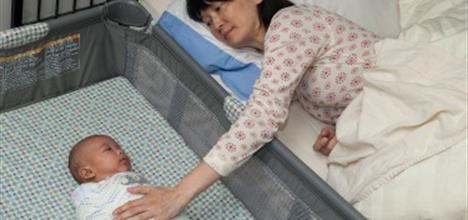How to Hold a Baby to Get Them to Sleep
Ages & Stages
How to Go on Your Sleeping Baby Safe: AAP Policy Explained


Page Content
Past: Rachel Y. Moon, Md, FAAP
About 3,400 babies in the U.Due south. die suddenly and unexpectedly every year while sleeping, often due to sudden infant decease syndrome (SIDS) or accidental deaths from suffocation or strangulation.
In an try to reduce the risk of all sleep-related infant deaths, the American Academy of Pediatrics' (AAP) updated policy statement and technical report includes new show that supports skin-to-pare care for newborn infants; addresses the utilise of bedside and in-bed sleepers; and adds to recommendations on how to create a safe slumber environment.
Note: All of these recommendations, unless mentioned otherwise, are for babies up to i year of age. Talk with your pediatrician if you have questions about whatsoever of the recommendations listed.
Infant slumber safety recommendations
-
Until their starting time birthday, babies should sleep on their backs for all sleep times—for naps and at nighttime. Nosotros know babies who sleep on their backs are much less likely to die of SIDS than babies who sleep on their stomachs or sides. The problem with the side position is that the baby can roll more easily onto the stomach. Some parents worry that babies will choke when on their backs, but the babe'south airway anatomy and the gag reflex will go along that from happening. Even babies with gastroesophageal reflux (GERD) should sleep on their backs.
-
Newborns should exist placed skin-to-skin with their mother as soon after birth equally possible, at least for the first hour. After that, or when the mother needs to sleep or cannot do skin-to-skin, babies should be placed on their backs in the bassinet. While preemies may need to be on their stomachs temporarily while in the NICU due to breathing issues, they should be placed on their backs after the problems resolve, so that they tin get used to being on their backs and before going home.
-
Some babies will roll onto their stomachs. Y'all should always place your baby to sleep on the back, but if your infant is comfortable rolling both means (back to tummy, tum to back), and so you do not have to return your baby to the back. Withal, exist sure that there are no blankets, pillows, stuffed toys, or bumper pads around your baby, so that your babe does not whorl into whatsoever of those items, which could block airflow.
-
If your baby falls asleep in a car seat, stroller, swing, babe carrier, or sling, you lot should motion him or her to a firm sleep surface on his or her back as before long as possible.
-
Utilise a firm slumber surface. A crib, bassinet, portable crib, or play thousand that meets the safety standards of the Consumer Product Safety Commission (CPSC) is recommended along with a tight-fitting, firm mattress and fitted sheet designed for that particular product. Aught else should exist in the crib except for the baby. A business firm surface is a difficult surface; it should not indent when the baby is lying on it. Bedside sleepers that run across CPSC safety standards may be an choice, but there are no published studies that have examined the safety of these products. In improver, some crib mattresses and sleep surfaces are advertised to reduce the risk of SIDS. There is no evidence that this is true, but parents can use these products if they come across CPSC prophylactic standards.
-
Only bring your baby into your bed to feed or comfort. Place your infant back in his or her own sleep space when you lot are gear up to go to sleep. If in that location is any possibility that you might fall asleep, make certain at that place are no pillows, sheets, blankets, or any other items that could cover your baby'due south confront, head, and cervix, or overheat your baby. Equally soon as you wake up, be sure to move the baby to his or her ain bed.
-
Bed-sharing is not recommended for any babies. Even so, sure situations make bed-sharing even more than dangerous. Therefore, you should not bed share with your infant if:
-
Your baby is younger than 4 months old.
-
Your babe was born prematurely or with low birth weight.
-
Y'all or whatsoever other person in the bed is a smoker (even if yous do not smoke in bed).
-
The female parent of the baby smoked during pregnancy.
-
You accept taken any medicines or drugs that might make information technology harder for you to wake up.
-
You drank any booze.
-
You are not the infant'south parent.
-
The surface is soft, such equally a waterbed, sometime mattress, sofa, couch, or armchair.
-
There is soft bedding like pillows or blankets on the bed.
-
Room share—continue baby'south slumber expanse in the same room where you sleep for the first half dozen months or, ideally, for the beginning yr. Identify your babe's crib, bassinet, portable crib, or play k in your bedroom, close to your bed. The AAP recommends room sharing because it tin can subtract the risk of SIDS by equally much as 50% and is much safer than bed sharing. In addition, room sharing volition make it easier for you to feed, condolement, and watch your baby.
-
Keep soft objects, loose bedding, or any objects that could increase the risk of entrapment, suffocation, or strangulation out of the baby'due south sleep area. These include pillows, quilts, comforters, sheepskins, blankets, toys, bumper pads or similar products that attach to crib slats or sides. If you are worried well-nigh your infant getting cold, you tin apply babe sleep clothing, such every bit a wearable coating. In general, your baby should be dressed with only i layer more than than you are wearing.
-
Do not let your child autumn asleep on nursing pillows or pillow-like lounging pads. The CPSC warns that babies may whorl over onto their sides or stomachs and turn their heads into the soft fabric. Or, when propped up on an incline against the pillow or lounger, their heads tin can autumn frontward, blocking their airway.
-
Never place your baby to slumber on a burrow, sofa, or armchair. This is an extremely dangerous place for your babe to sleep.
-
It is fine to swaddle your baby. Still, make sure that the baby is always on his or her back when swaddled. The swaddle should not exist too tight or make it difficult for the baby to exhale or movement his or her hips. When your infant looks like he or she is trying to roll over, you should stop swaddling.
-
Try giving a pacifier at nap time and bedtime. This helps reduce the risk of SIDS, even if it falls out after the babe is asleep. If you lot are breastfeeding, wait until breastfeeding is going well before offering a pacifier. This usually takes 2-3 weeks. If you are not breastfeeding your baby, you tin offset the pacifier whenever you like. It'south OK if your baby doesn't want a pacifier. You can try offering over again afterward, but some babies merely don't like them. If the pacifier falls out afterward your baby falls asleep, you don't have to put information technology dorsum in.
What else parents tin do: recommendations for prenatal & postnatal
-
Practise not smoke during pregnancy or after your babe is born. Keep your baby away from smokers and places where people smoke. If you lot are a smoker or yous smoked during pregnancy, information technology is very important that you do not bed share with your baby. Likewise, keep your car and home fume-free. Don't smoke anywhere near your baby, even if you are outside.
-
Do not utilise alcohol or illicit drugs during pregnancy or later the baby is built-in. It is very important not to bed share with your baby if y'all accept been drinking alcohol or taken any medicines or illicit drugs that can brand information technology harder for you lot to wake up.
-
Breastfed babies have a lower take chances of SIDS. Breastfeed or feed your baby expressed chest milk. The AAP recommends breastfeeding as the sole source of nutrition for your baby for about 6 months. Even after you add solid foods to your baby's diet, continue breastfeeding for at least 12 months, or longer if yous and your infant desire.
-
Schedule and go to all well-kid visits . Your infant volition receive important immunizations at these doctor visits. Contempo evidence suggests that immunizations may have a protective effect against SIDS.
-
Make sure your infant has breadbasket fourth dimension while awake every mean solar day. Awake tummy time should be supervised by an awake adult. This helps with baby'due south motor evolution and prevents flat head syndrome. See Back to Slumber, Tummy to Play for more than information and ways to play with the babe during tummy time.
Apply circumspection when buying products
-
Utilise circumspection when a production claims to reduce the risk of SIDS. Wedges, positioners, special mattresses and specialized slumber surfaces have not been shown to reduce the risk of SIDS, according to the AAP.
-
Do non rely on home heart or animate monitors to reduce the gamble of SIDS. If you have questions about using these monitors for other health weather condition, talk with your pediatrician.
-
In that location isn't enough inquiry on bedside or in-bed sleepers. The AAP can't recommend for or against these products because there have been no studies that have looked at their effect on SIDS or if they increment the run a risk of injury and death from suffocation.
More information
- Inclined Sleepers and Other Baby Registry Items to Avoid
- Can SIDS be Prevented?
- Make Baby'south Room Safe: A Parent Checklist
About Dr. Moon:

Rachel Y. Moon, Md, FAAP is a pediatrician and SIDS researcher at the University of Virginia. She is also the Division Head of General Pediatrics and Professor of Pediatrics at the Academy of Virginia School of Medicine. Her research centers on SIDS and SIDS chance factors, specially in high chance populations, such as African-Americans and infants attending kid care. Inside the American University of Pediatrics (AAP), she is chair of the Task Forcefulness on SIDS and Associate Editor for the journal Pediatrics. Dr. Moon is as well the editor of Sleep: What Every Parent Needs to Know.
Article Body
- Last Updated
- 6/i/2021
- Source
- American Academy of Pediatrics (Copyright © 2016)
The information contained on this Spider web site should non exist used as a substitute for the medical intendance and advice of your pediatrician. At that place may exist variations in handling that your pediatrician may recommend based on individual facts and circumstances.
hargroveallonce1964.blogspot.com
Source: https://healthychildren.org/English/ages-stages/baby/sleep/Pages/A-Parents-Guide-to-Safe-Sleep.aspx
0 Response to "How to Hold a Baby to Get Them to Sleep"
Postar um comentário